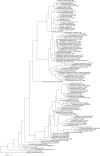Living in Cold Blood: Arcobacter, Campylobacter, and Helicobacter in Reptiles
- PMID: 31191467
- PMCID: PMC6530492
- DOI: 10.3389/fmicb.2019.01086
Living in Cold Blood: Arcobacter, Campylobacter, and Helicobacter in Reptiles
Abstract
Species of the Epsilonproteobacteria genera Arcobacter, Campylobacter, and Helicobacter are commonly associated with vertebrate hosts and some are considered significant pathogens. Vertebrate-associated Epsilonproteobacteria are often considered to be largely confined to endothermic mammals and birds. Recent studies have shown that ectothermic reptiles display a distinct and largely unique Epsilonproteobacteria community, including taxa which can cause disease in humans. Several Arcobacter taxa are widespread amongst reptiles and often show a broad host range. Reptiles carry a large diversity of unique and novel Helicobacter taxa, which apparently evolved in an ectothermic host. Some species, such as Campylobacter fetus, display a distinct intraspecies host dichotomy, with genetically divergent lineages occurring either in mammals or reptiles. These taxa can provide valuable insights in host adaptation and co-evolution between symbiont and host. Here, we present an overview of the biodiversity, ecology, epidemiology, and evolution of reptile-associated Epsilonproteobacteria from a broader vertebrate host perspective.
Keywords: Arcobacter; Campylobacter; Epsilonproteobacteria; Helicobacter; biodiversity; ecology; evolution; reptile.
Figures
Similar articles
-
Occurrence, diversity, and host association of intestinal Campylobacter, Arcobacter, and Helicobacter in reptiles.PLoS One. 2014 Jul 2;9(7):e101599. doi: 10.1371/journal.pone.0101599. eCollection 2014. PLoS One. 2014. PMID: 24988130 Free PMC article.
-
Use of an improved atpA amplification and sequencing method to identify members of the Campylobacteraceae and Helicobacteraceae.Lett Appl Microbiol. 2014 Jun;58(6):582-90. doi: 10.1111/lam.12228. Epub 2014 Mar 8. Lett Appl Microbiol. 2014. PMID: 24517729
-
Comparative Genomics of Campylobacter fetus from Reptiles and Mammals Reveals Divergent Evolution in Host-Associated Lineages.Genome Biol Evol. 2016 Jul 2;8(6):2006-19. doi: 10.1093/gbe/evw146. Genome Biol Evol. 2016. PMID: 27333878 Free PMC article.
-
Diversity of the Epsilonproteobacteria Dsb (disulfide bond) systems.Front Microbiol. 2015 Jun 9;6:570. doi: 10.3389/fmicb.2015.00570. eCollection 2015. Front Microbiol. 2015. PMID: 26106374 Free PMC article. Review.
-
Understanding the vertebrate immune system: insights from the reptilian perspective.J Exp Biol. 2010 Mar 1;213(5):661-71. doi: 10.1242/jeb.038315. J Exp Biol. 2010. PMID: 20154181 Review.
Cited by
-
Zoonotic potential and prevalence of Salmonella serovars isolated from pets.Infect Ecol Epidemiol. 2021 Sep 8;11(1):1975530. doi: 10.1080/20008686.2021.1975530. eCollection 2021. Infect Ecol Epidemiol. 2021. PMID: 34531964 Free PMC article. Review.
-
A Systematic Review on the Role of Wildlife as Carriers and Spreaders of Campylobacter spp.Animals (Basel). 2023 Apr 13;13(8):1334. doi: 10.3390/ani13081334. Animals (Basel). 2023. PMID: 37106897 Free PMC article. Review.
-
Prevalence and diversity of Helicobacter species in captive wild carnivores, and their implications for conservation management of endangered species.BMC Vet Res. 2025 Jul 29;21(1):498. doi: 10.1186/s12917-025-04886-7. BMC Vet Res. 2025. PMID: 40731010 Free PMC article.
-
Loggerhead Sea Turtles as Hosts of Diverse Bacterial and Fungal Communities.Microb Ecol. 2024 May 30;87(1):79. doi: 10.1007/s00248-024-02388-x. Microb Ecol. 2024. PMID: 38814337 Free PMC article.
-
Molecular detection and genetic characterization of Arcobacter butzleri isolated from red-footed pet tortoises suspected for Campylobacter spp. from Grenada, West Indies.PLoS One. 2020 Mar 16;15(3):e0230390. doi: 10.1371/journal.pone.0230390. eCollection 2020. PLoS One. 2020. PMID: 32176736 Free PMC article.
References
-
- Ahasan M. S., Waltzek T. B., Huerlimann R., Ariel E. (2018). Comparative analysis of gut bacterial communities of green turtles (Chelonia mydas) pre-hospitalization and post-rehabilitation by high-throughput sequencing of bacterial 16S rRNA gene. Microbiol. Res. 207 91–99. 10.1016/j.micres.2017.11.010 - DOI - PubMed
-
- Benejat L., Gravet A., Sifré E., Ben Amor S., Quintard B., Mégraud F., et al. (2014). Characterization of a Campylobacter fetus-like strain isolated from the faeces of a sick leopard tortoise (Stigmochelys pardalis) using matrix-assisted laser desorption/ionization time of flight as an alternative to bacterial 16S rDNA phylogeny. Lett. Appl. Microbiol. 58 338–343. 10.1111/lam.12194 - DOI - PubMed
-
- Blaser M. J., Newell D. G., Thompson S. A., Zechner E. L. (2008). “Pathogenesis of Campylobacter fetus,” in Campylobacter eds Nachamkin I., Szymanski C. M., Blaser M. J. (Washington, DC: ASM Press; ) 401–428.
Publication types
LinkOut - more resources
Full Text Sources
Molecular Biology Databases


